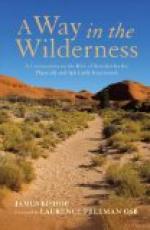There is another way in which he is easily fooled. In the early spring, when he is mating, and again in the autumn, when the young birds are well fed and before they have learned much, you can bring him close up to you by imitating his hunting call. In the wilderness, where these birds are plenty, I have often had five or six about me at once. You have only to go well out beyond your tent, and sit down quietly, making yourself part of the place. Give the call a few times, and if there is a young bird near with a full stomach, he will answer, and presently come nearer. Soon he is in the tree over your head, and if you keep perfectly still he will set up a great hooting that you have called him and now do not answer. Others are attracted by his calling; they come in silently from all directions; the outcry is startling. The call is more nervous, more eerie, much more terrifying close at hand than when heard in the distance. They sweep about like great dark shadows, hoo-hoo-hooing and frolicking in their own uncanny way; then go off to their separate watch towers and their hunting. But the chances are that you will be awakened with a start more than once in the night, as some inquisitive young owl comes back and gives the hunting call in the hope of finding out what the first summons was all about.
V. CHIGWOOLTZ THE FROG.
[Illustration: Chigwooltz]
I was watching for a bear one day by an alder point, when Chigwooltz came swimming in from the lily pads in great curiosity to see what I was doing under the alders. He was an enormous frog, dull green with a yellowish vest—which showed that he was a male—but with the most brilliant ear drums I had ever seen. They fairly glowed with iridescent color, each in its ring of bright yellow. When I tried to catch him (very quietly, for the bear was somewhere just above on the ridge) in order to examine these drums, he dived under the canoe and watched me from a distance.
In front of me, in the shallow water along shore, four more large frogs were sunning themselves among the lily pads. I watched them carelessly while waiting for the bear. After an hour or two I noticed that three of these frogs changed their positions slightly, turning from time to time so as to warm the entire body at nature’s fireplace. But the fourth was more deliberate and philosophical, thinking evidently that if he simply sat still long enough the sun would do the turning. When I came, about eleven o’clock, he was sitting on the shore by a green stone, his fore feet lapped by tiny ripples, the sun full on his back. For three hours, while I watched there, he never moved a muscle. Then the bear came, and I left him for more exciting things.
Late in the afternoon I came back to get some of the big frogs for breakfast. Chigwooltz, he with the ear drums, was the first to see me, and came pushing his way among the lily pads toward the canoe. But when I dangled a red ibis fly in front of him, he dived promptly, and I saw his head come up by a black root, where he sat, thinking himself invisible, and watched me.




